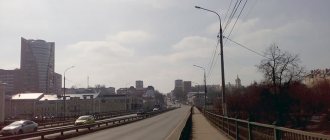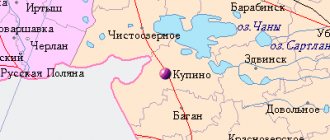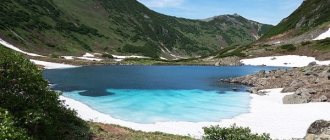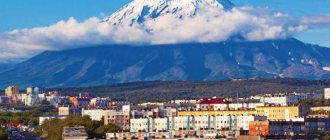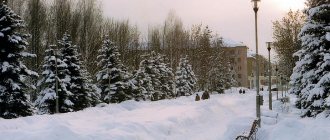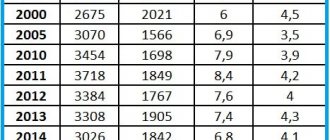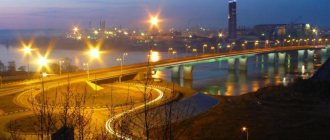Year founded: 600 BC
Kerch. View of Mount Mithridates from the central square (Photo: ru.wikipedia.org)
Kerch
- a city in Crimea, located on the Kerch Peninsula along the coast of the Black and Azov Seas and the Kerch Strait connecting them. Modern Kerch extends more than 40 kilometers along the coastline from Cape Fonar in the northeast to Cape Kara-Burun in the southwest.
Kerch is one of the oldest cities in the world
, was known under the name
Panticapaeum
from the 6th century BC, but people lived here in the 7th millennium BC. More than 26 centuries ago, the modern territory of the city was colonized and settled by the Milesian Greeks, who founded the ancient cities on it: Panticapaeum, Myrmekios, Tiritaku, Nymphaeum, Ilurat, Parthenius, Heraclius, Porthmios and others, which were then part of the Bosporus Kingdom, whose capital was Panticapaeum. In the 2nd century BC. The Bosporan kingdom falls under the rule of Rome.
Over the course of many centuries, the city was destroyed by the Gotths, captured by the Huns and Khazars, and was the northeastern outpost of Byzantium... From the 8th to the 12th centuries, the city under the name Krchav was the western part of the Russian Tmutarakan principality. In the 13th century it was inhabited by the Tatars, and in 1318 the city passed to the Genoese, who in 1475 came under the rule of the Turkish Empire. Since 1774, Kerch became the first Russian city in Crimea.
Temple of the beheading of John the Baptist. 10th century (ru.wikipedia.org) In the city at the beginning of the 20th century there were two gymnasiums (male and female), a maritime school for coastal navigation and a girls' institute. After decline caused by World War I and the Civil War, the city resumed its growth. By 1939, the city's population reached 104.5 thousand people. In 1940, there were 109 enterprises in the city, employing 42 thousand people.
During the Great Patriotic War, Kerch became the scene of fierce battles. The front line passed through Kerch four times. After heavy fighting in November 1941, the Germans captured the city. The city was liberated in 1944. In 1973, Kerch was awarded the title of Hero City with the Order of Lenin and the Gold Star medal.
After Ukraine declared independence in 1991 and until March 2014, Kerch was part of Ukraine.
In March 2014, during the Crimean crisis, deputies of the Sevastopol City Council, together with deputies of the Supreme Council of the Autonomous Republic of Crimea, adopted a joint Declaration of Independence of the Autonomous Republic of Crimea and the city of Sevastopol, and then held a national referendum on the status of Crimea.
Two-pylon composition above the Defense Museum of the Adzhimushkai Quarries (ru.wikipedia.org)
On March 18, 2014, an interstate agreement was signed between Russia and the Republic of Crimea, according to which the Republic of Crimea was admitted to the Russian Federation and became a new subject of Russia. And from that moment on, Kerch, accordingly, became a Russian city.
Now the city's population is about 145 thousand people (2014). The inhabitants of the city are called Kerchans or Kerchens.
The rich cultural and historical heritage of the city provides the basis for scientific tourism. The most famous sights of Kerch are: the ancient settlement of Panticapaeum, the Royal Mound (the tomb of one of the Bosporan kings), the Church of John the Baptist, the Yeni-Kale fortress, the large Mithridates staircase (428 steps), the Obelisk of Glory on Mount Mithridates, the museum complex in the Adzhimushkaya quarries, the Nymphaeum, Parus, Kerch fortress (18th century).
Obelisk of Glory on Mount Mithridates (ru.wikipedia.org)
In the vicinity of the city there are a number of boarding houses and recreation centers. There are several healing mud springs on the Kerch Peninsula.
Sergei Dorenko (Russian journalist), Ulyana Lopatkina (People's Artist of Russia, ballerina), Alena Sviridova (Russian singer) and others were born in this city.
Many films, wholly or partially, were filmed in Kerch: “Those Who Descended from Heaven” (1986), “Stalingrad” (1989), “Whistle all up!” (1970), “Full Breath” (2007), “Inhabited Island” (2008).
People call Kerch the city of the Griffin (the griffin was a symbol of the Bosporan Kingdom) or the capital of two Parts of the World.
Day of the city
Kerch celebrates in September. Traditionally, throughout this day, creative groups perform in various districts of Kerch. The celebration ends with a gala concert and fireworks.
In addition to City Day, Kerch residents widely celebrate the Day of the Liberation of Kerch from the Nazi invaders, April 11 (1944), and Fisherman's Day.
General information and brief history
In the beautiful bay of the Kerch Peninsula, at the place where the waters of the Black Sea and Azov meet, at the base of Mount Mithridates, a small city, now called Kerch, is comfortably located.
The history of the city is very complicated; there have been wars, victories and defeats. The territory of the city has been inhabited by people for 7 thousand years, but Kerch became a “city” 2600 years ago. Thanks to such a long history, Kerch, according to the UN, is included in the list of the most ancient cities, along with Athens and Rome. 26 centuries ago, the city was founded by travelers from the city of Miletus (Greece) and gave the name of the current Kerch - Panticapaeum.
Entrance to the city
During the existence of the city, Kerch turned out to be a very attractive “prey” for the rulers of different countries. So, the rulers of the Byzantine Empire gave the city the name Bosporus, then the Slavs appeared, and the city began to be called Korchev. The Khazar Kaganate also turned out to be not indifferent to the city. An Italian city was founded here under the name Cerchio, then Kerch came under Turkish rule and became known as Karsha.
But even wars did not stop the flow of life in the city. Its residents are true patriots of their small homeland, and the Great Patriotic War is a special “pain” for people. The territory of the city was practically saturated with the blood of Soviet soldiers shed during the war, and there is not a family in Kerch that does not grieve for those killed in those days. For the courage shown and the exploits of the heroes, the city was awarded the honorary title “Hero City”.
In general, the city of Kerch is quite large, with an area of 107 sq. km., its neighborhoods are scattered over 40 km along the coast of the strait. If compared with other cities of Crimea, Kerch is located very well. There are 2 seas, sandy beaches, nature reserves, and an excellent climate for living.
Archeology
Systematic excavations in Kerch began in the 30s of the 19th century. In 1830, excavations were carried out at the famous Kul-Oba mound (Hill of Ashes), in which a large number of Scythian gold jewelry was found. The excavations were carried out under the direction of Paul Dubrux. His personal collection became the basis of the Kerch Museum of Antiquities (Kerch Historical and Archaeological Museum) opened in 1826. The museum's funds contain more than 130 thousand museum objects. The museum's collection continues to be replenished every year with new finds. Currently, excavations at the ancient settlements of Kerch are being carried out by scientists from Russia, Ukraine and Poland.
Within the city there are several mounds - burial structures under a high artificial embankment. Treasures and historical finds from Kerch adorn the collections of the largest museums in the world, such as the Hermitage, Louvre, British Museum, Berlin Museum, Moscow State Museum of Fine Arts. A. S. Pushkin. Kerch is included in the international UNESCO Silk Road program
Climate and ecology of Kerch
The temperate climate, almost subtropical, creates excellent living conditions for the population. Winters are often snowless. The last winters of 2011-2014 were quite cold, the frost grew to -15 degrees. During frosts, the strait between Russia, Kuban and Kerch becomes covered with ice.
Summer brings with it +35 degrees, stuffiness and mosquitoes, and sometimes heavy rain. Sudden weather changes are generally not typical for Kerch. Massive swimming here begins in May; this time of year in Kerch is especially wonderful. The alleys are covered with the fire of tulip blossoms and the aroma of lilacs, the smells soar throughout all the outskirts.
A mountain range runs through the central part of the city, and the highest point of the ridge is the legendary Mount Mithridates. The city of Panticapaeum was built here, and Emperor Mithridates VI Eupator ruled here. From the top you can clearly see the center and the Voikovo region.
Great Mithridatic Staircase
Not far from Kerch there are 2 nature reserves - Kazantipsky and Opuksky. These open spaces are considered natural monuments, with unique nature, endemic fauna and flora of the peninsula. In the Opuk Reserve, excavations of the ancient city of Cimmeric (5th century BC) are being carried out.
The ecology in the city is very good, the air is clean and sea. There are very few enterprises that pollute the environment. For example, when working with coal on the territory of a commercial port, coal dust flies across the yards closest to the port, settling on windows and window sills.
Population of Kerch
Due to its rich history, the city of Kerch is very multinational; more than 80 different nationalities live on its territory. Perhaps this is precisely the charm of this seaside town. Under one “roof” Russians (78%), Ukrainians (15%), Tarats (2%), Armenians, Italians and other nationalities exist peacefully.
In 2013, the population was 145.3 thousand people, of which the working population was 87.9 thousand people. Official unemployment in the city reaches 1.5%. The largest number of the population of Kerch are citizens from 25 to 44 years old - 29.5%.
Secondary education in Kerch can be obtained in the following educational institutions:
- Higher Maritime Vocational School;
- Higher Vocational School of Shipbuilding and Woodworking;
- Vocational school for consumer services;
- Professional construction lyceum.
Young people are trained in the following specialties: navigator, sailor, motor mechanic, electric and gas welder, turner, ship hull assembler, gas cutter, carpenter and wood carver, salesman, cashier controller, bartender and waiter, hairdresser and manicurist, secretary, car mechanic, plasterer, painter, bricklayer and etc.
Universities of Kerch are represented by the following universities: State Marine Technological University, Engineering and Pedagogical University, Economics and Humanities Institute of Tauride National University named after. Vernadsky. Students have the opportunity to receive education in specialties - economist, navigator, ship electrician, financier, ecologist, philologist and many others. But not all specialties are represented in city universities, and students often have to go to study in other cities.
Kerch University of Economics and Humanities TNU named after. Vernadsky
The city regularly hosts sports competitions, beauty contests, student theaters and clubs, music groups are created and concerts are held. In Kerch there are theater troupes and cultural centers, a sports palace, cinemas, and there are music and art schools. The favorite holiday for many Kerchan residents is May 9 - Victory Day; a parade and meetings with veterans take place on Lenin Square. The evening of May 8 is marked by a torchlight procession; all residents of the city with lit torches in a column walk along the main streets of the city and ascend Mithridates in an organized manner. This event brings together a lot of city guests from different countries.
Torchlight procession
Significant holidays for Kerch are Fisherman's Day and City Day. Sales fairs, fun events, a carnival, concerts are held; guests are treated to aromatic fried fish and fish soup on the embankment. And, of course, every holiday in the city does not pass without beautiful fireworks.
CONTENT
- 1 History 1.1 Ancient times
- 1.2 Middle Ages
- 1.3 18th-20th centuries
- 1.4 Kerch in World War II
- 1.5 Recent events
- 2.1 Climate
- 4.1 Industry
- 5.1 Festivals and holidays
Districts and real estate of Kerch
According to its territorial division, Kerch can be conditionally divided into 3 main areas: Center, plant area named after. Voikogo and Arshintsevo. In addition, the city has many microdistricts, such as BAM, 7 Vetrov, Marat 1-5, Birzha, Kapkany, Stroygorodok, Yaponka, Gorka, etc., as well as the villages of Geroevskoye, Adzhimushkay, Mayak, Opasnoe and Tuzla Island.
There are 16 different parks and squares throughout the city. A third of the streets and alleys of the city are densely covered with green trees and shrubs. Especially the Arshintsevo and Voikovo districts are the living gardens of the city.
Center
The most comfortable residential area is the central area of the city. Half of the total population lives here.
View from Mount Mithridates to the city center
Most of the streets are landscaped, children's and sports grounds have been renovated. In this area there is a central market, a bus station, a railway station, city hospital No. 1, a blood transfusion station, many beauty salons and the bulk of banks, government agencies and recreational facilities. In a word, the area has everything necessary for the life of the population. There are no problems with water, electricity or gas supply, and if they do arise, they are resolved very quickly.
Real estate in the central area is the most expensive compared to other areas of the city. In the new building there is a 4-room apartment of 139 sq.m. in the city center you can buy for $175,000, 3-room - $137,000, 2-room - for $85,000, 1-room - for $65,000.
View from Mount Mithridates to the embankment, center
The price of apartments on the secondary housing market varies significantly - for a 4-room apartment they ask for $64,000, for a 3-room apartment - $60,000, for a 2-room apartment - $47,000, for a 1-room apartment - $38,000.
Arshintsevo village
The village of Arshintsevo (previously called Kamysh-Burun, from Tatar “reed cape”) is located in the southwestern part of Kerch. Arshintsevo compares favorably with other areas with an abundance of greenery; all the alleys here are buried in acacias, poplars and plane trees. In the spring and summer, Arshintsevo is fragrant with various aromas of steppe herbs and flowers, mixed with the aromas of the sea breeze.
Nesterova Street, Arshintsevo
The bulk of residential buildings in Arshintsevo are old housing stock, houses built in the 50-70s. But this does not prevent them from being well-groomed and attractive to potential buyers. In the courtyards there are children's, sports and laundry areas, as well as parking areas. But the internal roads in some courtyards require repairs.
St. Boulevard of Pioneers, Arshintsevo
In the immediate vicinity of the courtyards there are garage cooperatives where you can not only purchase a car garage, but also rent it.
The population of Arshintsevo is fully provided with schools and kindergartens, cultural institutions for recreation. In the heart of Arshintsevo there is a Youth Park, with attractions and a children's playground. The park has long been a favorite of mothers who enjoy watching their children play in this wonderful corner of nature. The air is filled with the smell of pines and oaks, chestnuts and plane trees. The park overlooks the sea.
There are practically no new buildings in Arshintsevo. For a 4-room apartment (secondary housing) they are asking $40,000, a 3-room apartment – $35-40,000, a 2-room apartment – $30,000, a 1-room apartment – $23,000.
From the village of Arshintsevo you can reach almost all areas of the city without transfers. It is from Arshintsevo that buses go to the city beach and Sandaly beach, as well as to the resort village of Geroevskoye.
I would like to pay special attention to the village of Gerovskoye, it is located 10 minutes drive from Arshintsevo.
Private houses in the village of Geroevskoye
This is a small resort village with a wonderful Black Sea coast and a sandy beach, where you can find relaxation, fun, and solitude. The sea in this area warms up already from May, so people start swimming here very early, and the holiday season lasts until October. Housing can be rented or purchased right off the coast. Renting a house without special amenities for 1 person will cost from $8 per day, with amenities - from $25 for a double room. The village has a large number of private boarding houses, which will provide accommodation and food, and will also pay attention to every tourist.
Recreation center, village. Geroevskoe
Voykovo District
Finally, the third district of the year Kerch is the Voykovo district. The majority of local high-rise buildings (9 and 14 floors) are located in this area. There is a market, supermarkets, a beach, schools and kindergartens, an art school. A very good residential area to live in. Voikovo is connected to the city center by a trolleybus line. Almost the entire area has been landscaped, internal roads have been repaired, the area has been illuminated and landscaped.
General view of the Voikovo district from Mount Mithridates
There are also no new buildings in the Voikovo area, so real estate is represented only by the secondary housing market. Prices for a 4-room apartment are $40-45,000, a 3-room apartment is $35-40,000, a 2-room apartment is from $25,000, a 1-room apartment is from $15,000. The area is pleasant because, despite the abundance of residential buildings and shops, the sea and equipped free beaches for the population are nearby.
Microdistrict Luch, Voikovo
Geography
Kerch, view from Mount Mithridates
Climate
Kerch has a humid subtropical climate (Köppen climate classification Cfa
) [10] with cool or cold winters and warm or hot summers.
| Climate data for Kerch (1981–2010, extreme periods 1936 to present) | |||||||||||||
| Month | Jan | Feb | Mar | Apr | Maybe | Jun | Jul | Aug | Sep | October | But I | December | Year |
| Record high °C (°F) | 15,6 (60,1) | 17,5 (63,5) | 23,4 (74,1) | 27,6 (81,7) | 30,6 (87,1) | 35,2 (95,4) | 37,7 (99,9) | 37,9 (100,2) | 35,5 (95,9) | 30,9 (87,6) | 23,2 (73,8) | 19,4 (66,9) | 37,9 (100,2) |
| Average high °C (°F) | 3,5 (38,3) | 3,8 (38,8) | 7,8 (46,0) | 14,3 (57,7) | 20,2 (68,4) | 25,0 (77,0) | 28,1 (82,6) | 27,8 (82,0) | 22,6 (72,7) | 16,3 (61,3) | 9,8 (49,6) | 5,3 (41,5) | 15,4 (59,7) |
| Daily average °C (°F) | 0,6 (33,1) | 0,4 (32,7) | 3,8 (38,8) | 9,8 (49,6) | 15,4 (59,7) | 20,3 (68,5) | 23,4 (74,1) | 23,1 (73,6) | 17,9 (64,2) | 12,2 (54,0) | 6,2 (43,2) | 2,4 (36,3) | 11,3 (52,3) |
| Average low °C (°F) | −2,1 (28,2) | -2,5 (27,5) | 0,5 (32,9) | 5,8 (42,4) | 10,8 (51,4) | 15,5 (59,9) | 18,6 (65,5) | 18,4 (65,1) | 13,3 (55,9) | 8,3 (46,9) | 3,2 (37,8) | -0,3 (31,5) | 7,5 (45,5) |
| Record low °C (°F) | -23,7 (-10,7) | -23,1 (-9,6) | -15,6 (3,9) | -6,5 (20,3) | -1,1 (30,0) | 2,8 (37,0) | 9,9 (49,8) | 7,5 (45,5) | 1,0 (33,8) | -5,4 (22,3) | -11,8 (10,8) | -17,6 (0,3) | -23,7 (-10,7) |
| Average precipitation, mm (inches) | 33 (1,3) | 32 (1,3) | 34 (1,3) | 32 (1,3) | 30 (1,2) | 56 (2,2) | 35 (1,4) | 49 (1,9) | 37 (1,5) | 29 (1,1) | 45 (1,8) | 43 (1,7) | 454 (17,9) |
| Average rainy days | 10 | 9 | 11 | 11 | 9 | 10 | 6 | 6 | 8 | 9 | 11 | 11 | 111 |
| Average snow days | 8 | 8 | 5 | 0,2 | 0 | 0 | 0 | 0 | 0 | 0,1 | 2 | 7 | 30 |
| Average relative humidity (%) | 85 | 84 | 80 | 76 | 73 | 71 | 67 | 67 | 71 | 77 | 83 | 85 | 77 |
| Average sunshine hours per month | 70 | 88 | 145 | 190 | 274 | 306 | 334 | 308 | 252 | 184 | 91 | 56 | 2,298 |
| Source 1: Pogoda.ru.net [11] | |||||||||||||
| Source 2: NOAA (Sun, 1961–1990) [12] | |||||||||||||
Infrastructure condition
Kerch is a port city near two seas. The Kerch Sea Trade Port and the only ferry in Crimea provide intercity and international transportation. Railway cars, buses, cars and citizens regularly depart via the ferry crossing to Kuban.
The city's transport network is represented by a predominant number of minibuses (GAZelles), as well as buses and trolleybuses. The average fare for a route taxi is $0.27, for a bus $0.2, and for trolleybuses $0.15. There are no traffic congestions. But the road surface itself often requires repairs. The main roads in the city are smooth, without potholes. But the same cannot be said about the condition of the roads within the block - either potholes after repairs to water pipelines or destroyed sidewalk paths.
There is regular bus service between the cities of Crimea, Ukraine and Russia (including Moscow, Sochi, Krasnodar, Anapa, etc.). There is also a railway station in Kerch, which provides connections with the cities of Ukraine and Russia. In the near future, it is planned to build a bridge across the Kerch Strait, which will connect the transport networks of Crimea and the Krasnodar Territory.
Unfortunately, there is no passenger airport in Kerch. The nearest airport is in Simferopol. But not far from Kerch there is the Bagerovo military airfield, intended for heavy bomber aircraft. During Soviet times, this airfield could be used as a reserve landing strip for the Buran orbital spacecraft. But at the moment the airport is not operating, although the surface of the airfield itself is in good condition. Apparently, it is waiting for a competent owner.
Train Station
The housing and communal services sector is represented by three municipal enterprises in the city districts. Each individual home has its own unique tariffs, agreed upon with the residents. Residents of the houses included the services they needed in these tariffs. On average in the city, the rent rate ranges from $0.1 to $0.3 per 1 sq.m. per month.
In recent years, residential neighborhoods have been reconstructed in Kerch, with the renovation of house facades, local areas and water supply and heating networks; apartments for orphans are allocated and renovated. Hospitals and kindergartens are being renovated, streets and squares are being renovated.
As for utilities, gas for the population costs $0.07 per 1 cubic meter, the cost of electricity is: preferential up to 150 kW at $0.028 per 1 kW and over 150 kW at $0.036 per 1 kW; for 1 cubic meter residents pay $0.8 for water. Interruptions in gas, water and electricity supplies occur only during repair work.
The resort and tourism business is actively developing. The city pays special attention to equipment and sanitary cleaning of the city's beaches. Before the start of the holiday season, all children's playgrounds, sports grounds, and recreation areas are checked.
The city is provided with a sufficient number of educational institutions; there are 21 secondary schools, 21 preschool educational institutions, a city orphanage, an educational and production plant and 5 out-of-school institutions, 2 gymnasiums, 2 lyceums, 5 colleges and 5 higher educational institutions.
Enterprises and work in Kerch
It is common to think that the main budget-forming enterprises are the enterprises that will be discussed further, although in our life we cannot be sure who fills the budget and how.
In the current situation, or rather since the collapse of the USSR, Kerch has not been a developed industrial center of Crimea for a long time. On the remains of some enterprises, namely the Kerch Iron Ore Plant, you can film horror films, and you don’t need to spend money on setting up decorations.
The most significant enterprises of the city: JSC Shipbuilding, LLC Kerch Switch, State Enterprise Kerch Ship Repair Plant, Sea Trade Port and Sea Fishing Port, as well as a building materials plant and a large number of food industry enterprises.
The average salary in the city for 2013 was $272.6.
At the moment, JSC Shipbuilding is in a very difficult financial situation. It is difficult to say whether the plant will remain as such and whether it will retain its profile. Over the past 2 years, workers: welders, assemblers, hull workers, working at this plant, received wages an order of magnitude lower than in Europe. Today at the plant, orders for the manufacture of ship hulls, work and wages for workers tend to zero.
Shipbuilding
State Enterprise “Kerch Shipyard” was founded on the basis of a unique and “rare” enterprise - the Mesaksudi tobacco factory, founded in 1893. In Soviet times it was a large-scale ship repair plant. The privatization procedure for this plant has been going on for the last 3 years. At the end of 2013 it was bought out. Over the period 1996-2013, the number of plant employees decreased from 2000 to 230 people. This speaks about the “success” of the plant and the level of remuneration of workers.
The Sea Trade Port has undergone significant changes over the past year. It was split into 2 organizations - the State Enterprise “Kerch Sea Commercial Port” and the Kerch branch of the State Enterprise “Administration of Sea Ports of Ukraine”. On the one hand, this was correct and competent, but in fact, the Trading Port faced the unhappy fate of other enterprises in the city. Once upon a time, the port was a single organization and specialized in the transshipment of coal, and its cargo flow ensured the payment of all taxes and labor of the port staff. Now, for unknown reasons, the port is out of work. For comparison: if a driver at the port received $350 in 2012, now he receives $150.
The Sea Fishing Port is the richest enterprise in the city. Despite its name, it stopped being fishy many years ago. The actual specialization of the port is the loading and unloading of grain, as well as the use of berths for loading and unloading petroleum products.
View from Mount Mithridates to the sea fishing port and the KUOR microdistrict, center
In Kerch there is a fishing industry consisting of 17 organizations that produce fish and process it. The largest enterprise in this industry is Proliv LLC, as well as PKRP Belaya Rus LLC and Kerch Fish Factory PJSC.
The transport industry of Kerch is represented by the following enterprises: ferry crossing, sea trade port, sea fishing port, DP "TIS-Crimea" and checkpoint "Kerchtrolleybus".
The ferry crossing has always been and is a profitable enterprise. The volume of passenger traffic through the Kerch Strait is so large that the 2 ferries “Kerch 2” and “Yeysk” cannot cope with this load in the summer. Accordingly, the enterprise is profitable, taxes are paid, and workers’ salaries are at a decent level. But the situation can change dramatically if a transport crossing (bridge, tunnel or other structure) is built between Kerch and Kuban. Construction will include the laying of electrical cables, water and gas pipelines.
At the moment, a cement plant is being built near Kerch near the village of Priozernoye. A large number of both city residents and visiting workers are involved here. It is difficult to assess the role of this plant in the life of the city, because a lot of positive and negative reviews from residents. The positive aspects are filling the budget and new jobs, the negative aspect is possible harmful emissions into the environment, which in case of unfavorable winds will be blown towards the city.
If we consider the employment of the population by type of economic activity, then the largest number of workers is in the industrial sector - 33%.
Particular attention is paid to the development of tourism and resort business. There are more than three dozen dispensaries, sanatoriums and boarding houses in Kerch. For some therapeutic and cosmetic procedures, the healing mud of the unique Lake Chokrak is used. In the summer of 2014, youth music festivals are planned to be held in Kerch, and the city leadership also plans to include the famous sailing ship “Khersones” in tourist entertainment. On the basis of the ship "Khersones" they plan to conduct educational tours for tourists, as well as tasting or gastronomic tours.
Crime
Currently, Kerch is a very quiet and peaceful city; apart from domestic crimes and ordinary offenses, there is nothing special to note. But 10-15 years ago, things were not calm in Kerch, gangs were gaining strength and banditry was flourishing. There were more than 30 gangs in provincial Kerch. It was rare that young people, especially athletic youth, did not get involved with such gangs.
They fought the gangs strictly - they shot them. In 1995, the “leaders” of the “Keta” gangs, Kovtunenko and Latyshev, were shot; in 1996, seven members of the gangster group, including bandits Kelzon and Katsyka, were shot dead in the Interclub. In 2002, the bandit Galitsky was shot. And in 2004, Korovchenko “Afghan” was declared “missing.” Laptev is wanted for committing murders "Lapot"
Current statistics
The Republic of Crimea (Crimean Federal District) is part of the Russian Federation. When talking about current statistics regarding the population living on these lands, they take into account not only the territory of the Republic itself, but also the city of Sevastopol, which has a special status.
Rosstat data show that as of January 1, 2022, 1,912,622 citizens live in Crimea (district), while in Sevastopol there are about 500 thousand inhabitants. The total population of the Republic of Crimea is 2,360,000 inhabitants. For comparison, in 2022, 1,912,775 people lived in the Republic of Crimea (about 20 more people in 2022).

